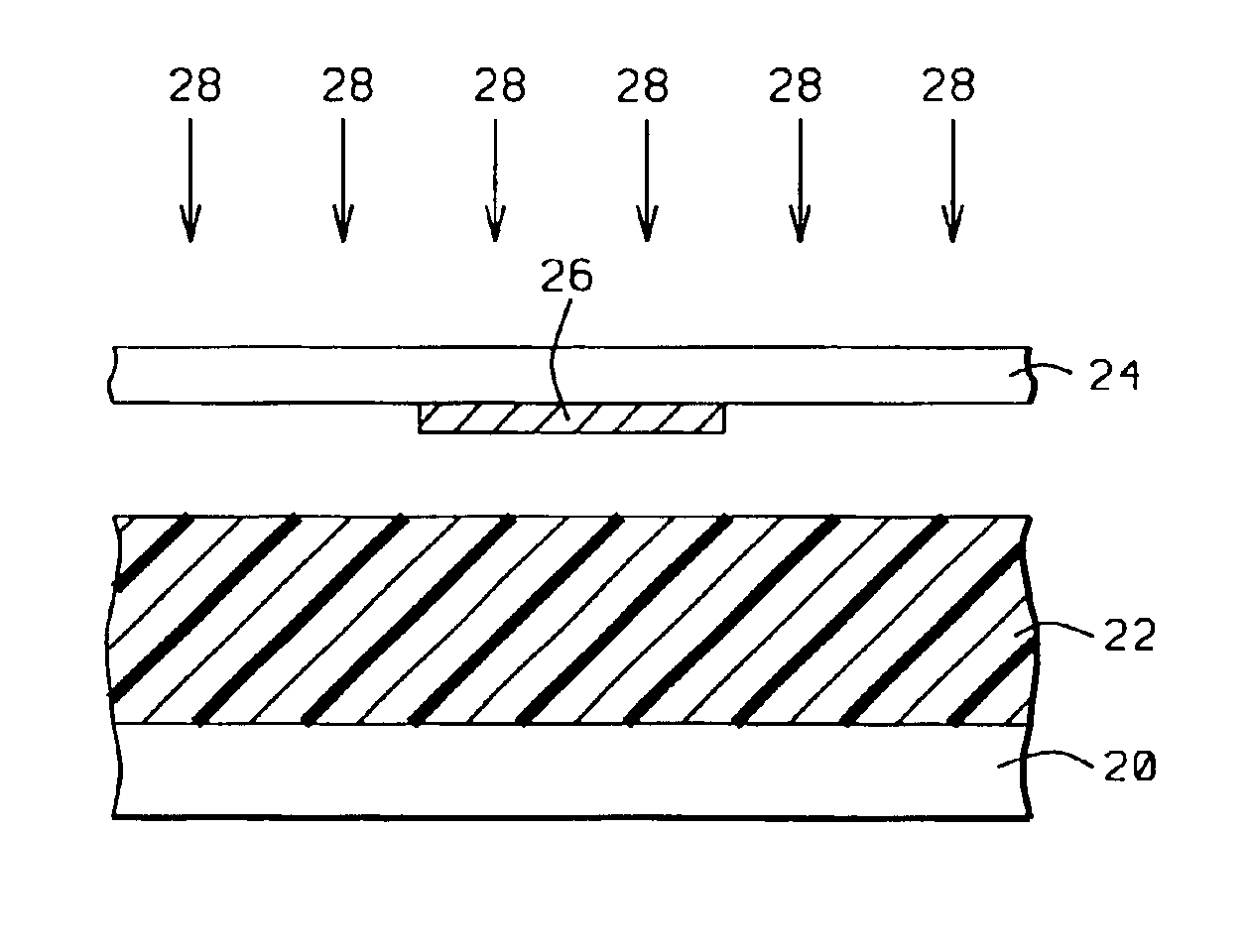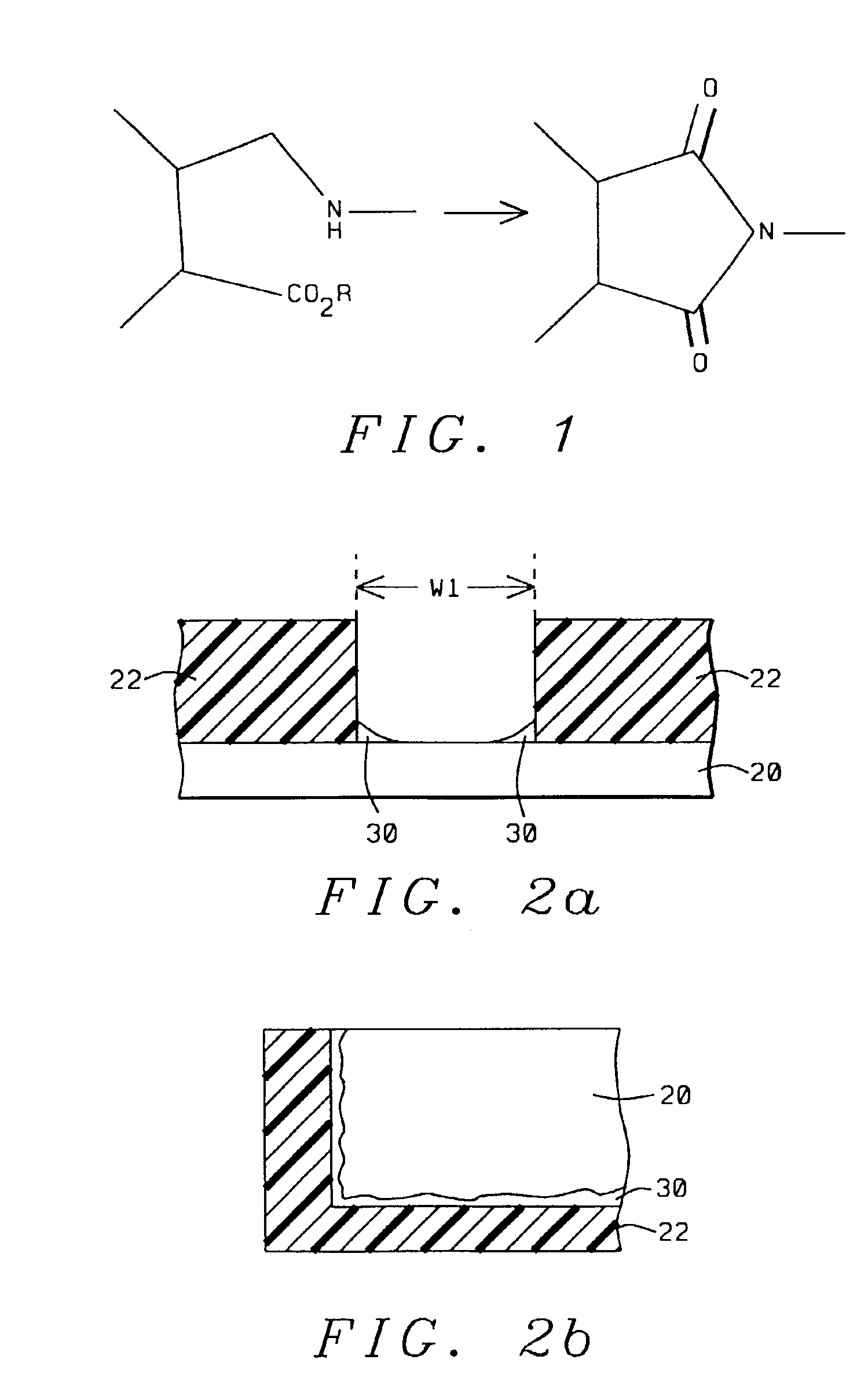Two step exposure to strengthen structure of polyimide or negative tone photosensitive material
a negative tone, polyimide technology, applied in the direction of photosensitive materials for photomechanical equipment, instruments, photomechanical treatment, etc., can solve the problems of reducing the height of the etch mask, difficult control, and etch selectivity, so as to reduce the amount of developer needed, reduce the amount of rework, and reduce the yield and reliability of the final device
- Summary
- Abstract
- Description
- Claims
- Application Information
AI Technical Summary
Benefits of technology
Problems solved by technology
Method used
Image
Examples
first embodiment
[0036]In the first embodiment as depicted in FIGS. 3a-3c, a substrate 20 is provided upon which a negative photosensitive polyimide precursor film 22 has been spin coated. The precursor material is typically a polyamic acid or polyamic ester. The thickness of film 22 can vary from a few microns to more than 10 microns and is preferably in a range of 8 to 10 microns after a low temperature bake that is, for example, about 100° C. for 5 minutes. Substrate 20 is silicon, ceramic or other appropriate materials that are common in semiconductor device manufacturing processes. Referring to FIG. 3a, a reticle or mask comprised of a transparent substrate 24 such as quartz and an opaque patterned coating 26 which is typically chrome or chromium is positioned between the exposure source 27 and the substrate 20. Radiation 28 from the exposure tool is blocked by opaque regions 26 on the mask and is transmitted through regions in quartz 24 which are not covered by chrome 26.
[0037]Exposure tools a...
second embodiment
[0048]In a second embodiment, the photosensitive composition is a negative tone photoresist formulation that is crosslinked by a free radical mechanism. Referring to FIG. 4a, the negative tone photoresist 44, hereafter referred to as negative resist, is spin coated on a polyimide precursor layer 42 that is on substrate 40. Negative resist 44 is patterned in the same manner as depicted in FIG. 3a with exposing radiation 28 from an exposure source and a mask comprised of a transparent substrate 24 and an opaque pattern 26. Layer 44 can be exposed with one or more wavelengths of radiation selected from a region extending from about 600 nm to about 300 nm including g-line (436 nm) and i-line (365 nm). Negative resist 44 is developed in an aqueous base solution to provide a pattern as shown in FIG. 4b with a space width W2 that can range from 1 or 2 microns to over 10 microns. Layer 44 can be several microns thick and is preferably 2 microns or less in thickness.
[0049]A second exposure d...
third embodiment
[0052]In a third embodiment, the photosensitive composition is a negative tone photoresist formulation that is crosslinked by a chemical amplification mechanism. Since a chemically amplified (CA) resist is sensitive to trace amounts of bases such as amines that are likely to be present in a polyimide layer, an intermediate layer is inserted between the cured polyimide and the negative resist. This embodiment provides a potentially smaller space width W3 than W1 or W2 afforded by the other embodiments because of the higher resolution of CA resists and the possibility of performing a pattern transfer with a more selective etch.
[0053]Referring to FIG. 5a, a cured polyimide layer 52 is provided on a substrate 50. A barrier layer 54 is then deposited by spin coating, a CVD method, or by sputtering. This layer primarily functions as a chemical barrier but is also useful as an etch stop or for its anti-reflective properties during patterning a photoresist above it. Suitable materials may b...
PUM
 Login to View More
Login to View More Abstract
Description
Claims
Application Information
 Login to View More
Login to View More - R&D
- Intellectual Property
- Life Sciences
- Materials
- Tech Scout
- Unparalleled Data Quality
- Higher Quality Content
- 60% Fewer Hallucinations
Browse by: Latest US Patents, China's latest patents, Technical Efficacy Thesaurus, Application Domain, Technology Topic, Popular Technical Reports.
© 2025 PatSnap. All rights reserved.Legal|Privacy policy|Modern Slavery Act Transparency Statement|Sitemap|About US| Contact US: help@patsnap.com



